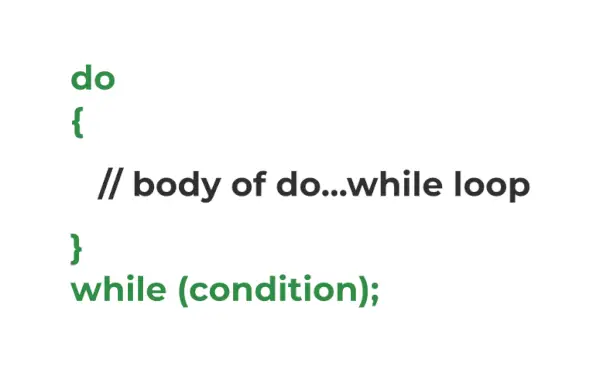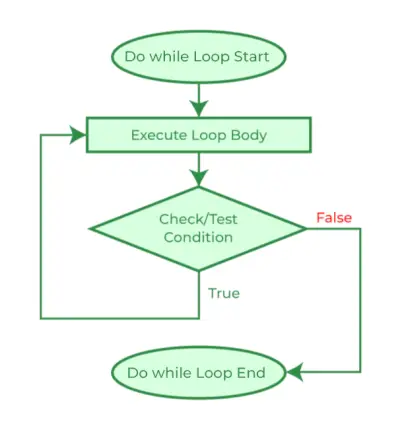Pętle w języku C to instrukcje przepływu sterowania, które służą do powtarzania pewnej części kodu, aż do spełnienia zadanego warunku. The pętla do-while jest jedną z trzech instrukcji pętli w C, pozostałe to pętla while i pętla for. Służy głównie do przeglądania tablic, wektorów i innych struktur danych.
Co to jest wykonaj…while Loop w C?
The zrobić… będąc w C to instrukcja pętli służąca do powtarzania pewnej części kodu, aż do spełnienia podanego warunku. Jest to forma pętla kontrolowana na wyjściu lub po testowaniu gdzie warunek testowy jest sprawdzany po wykonaniu treści pętli. Z tego powodu instrukcje w pętli do…while będą zawsze wykonywane co najmniej raz, niezależnie od warunku.
Składnia do…while Loop w C
do { // body of do-while loop } while ( condition );> Jak używać pętli do…while w C
Poniższy przykład ilustruje użycie pętli do…while w języku programowania C.
C
// C Program to demonstrate the use of do...while loop> #include> int> main()> {> >// loop variable declaration and initialization> >int> i = 0;> >// do while loop> >do> {> >printf>(>'Geeks
'>);> >i++;> >}>while> (i <3);> >return> 0;> }> |
>
>Wyjście
Geeks Geeks Geeks>
Jak działa funkcja do...while Loop?

Składnia Struktura pętli do while
Działanie pętli do…while wyjaśniono poniżej:
- Kiedy sterowanie programem po raz pierwszy dojdzie do pętli do…while, najpierw wykonywany jest korpus pętli, a następnie sprawdzany jest warunek/wyrażenie testowe , w przeciwieństwie do innych pętli, w których najpierw sprawdzany jest warunek testowy. Ze względu na tę właściwość pętla do…while nazywana jest także pętlą kontrolowaną przy wyjściu lub pętlą po testowaniu.
- Kiedy warunek testowy jest oceniany jako PRAWDA , kontrola programu idzie na start pętli i ciało jest wykonywane jeszcze raz.
- Powyższy proces jest powtarzany aż do spełnienia warunku testowego.
- Kiedy warunek testowy jest oceniany jako FAŁSZ, elementy sterujące programu przechodzą do kolejnych instrukcji po pętli do…while.
Podobnie jak w przypadku pętli while w C, inicjowanie i aktualizacja nie są częścią składni pętli do…while. Musimy to zrobić wyraźnie, odpowiednio przed i w pętli.
Poniższy schemat blokowy przedstawia wizualną reprezentację przepływu pętli do…while w C.
C wykonaj… podczas gdy schemat blokowy pętli

Schemat blokowy pętli do…while w C
Zagnieżdżone wykonanie…while Loop w C
Podobnie jak w przypadku innych pętli, możemy również zagnieździć jedną pętlę do…while w innej pętli. Zademonstrowano to za pomocą następującego programu w języku C.
Przykład zagnieżdżonej pętli do…while w C:
C
// C Program to demonstrate the nesting of do...while loop> #include> int> main()> {> >// declaring loop variables> >int> i = 0, j;> >int> count = 0;> >// outer loop starts> >do> {> >j = 0;> >// inner loop starts> >do> {> >printf>(>'%d '>, count++);> >j++;> >}>while> (j <3);> >// inner loop ends> >printf>(>'
'>);> >i++;> >}>while> (i <3);> >// outer loop ends> >return> 0;> }> |
>
>Wyjście
0 1 2 3 4 5 6 7 8>
Aby dowiedzieć się więcej o zagnieżdżonych pętlach w C, zapoznaj się z tym artykułem – Zagnieżdżone pętle w C z przykładami
Przykłady pętli do…while w C
Przykład 1. Program w C demonstrujący zachowanie pętli do…while, jeśli warunek od początku jest fałszywy.
C
tworzenie tablicy ciągów w Javie
// C Program to demonstrate the do...while loop behaviour> // when the condition is false from the start> #include> #include> int> main()> {> >// declaring a false variable> >bool> condition =>false>;> >do> {> >printf>(>'This is loop body.'>);> >}>while> (condition);>// false condition> >return> 0;> }> |
>
>Wyjście
This is loop body.>
Jak widzimy, nawet jeśli na początku warunek jest fałszywy, ciało pętli jest wykonywane jednokrotnie. Dzieje się tak dlatego, że w pętli do…while warunek sprawdzany jest po przejściu przez treść, zatem gdy kontrola jest na początku,
- Przechodzi przez korpus pętli.
- Wykonuje wszystkie instrukcje w treści.
- Sprawdza warunek, który okazuje się fałszywy.
- Następnie wychodzi z pętli.
Przykład 2. Program C wyświetlający tabliczkę mnożenia liczby N przy użyciu pętli do…while
Poniższy przykład ilustruje użycie pętli do…while do wydrukowania tabliczki mnożenia liczby N.
C
// C Program to print multiplication table using do...while> // loop> #include> int> main()> {> >int> N = 5, i = 1;> >do> {> >printf>(>'%d x %d = %d
'>, N, i, N * i);> >}>while> (i++ <10);> >return> 0;> }> |
>
co to znaczy xd
>Wyjście
5 x 1 = 5 5 x 2 = 10 5 x 3 = 15 5 x 4 = 20 5 x 5 = 25 5 x 6 = 30 5 x 7 = 35 5 x 8 = 40 5 x 9 = 45 5 x 10 = 50>
Różnica pomiędzy while i do...while Pętla w C
W poniższej tabeli wymieniono najważniejsze różnice pomiędzy while i do...while Loop w C.
| podczas Pętli | wykonaj… podczas pętli |
|---|---|
| Sprawdzany jest warunek testowy przed wykonaniem treści pętli. | Sprawdzany jest warunek testowy po wykonaniu ciała. |
| Gdy warunek jest fałszywy, ciało nie jest wykonywane ani razu. | Ciało do…while pętla jest wykonywana przynajmniej raz nawet jeśli warunek jest fałszywy. |
| Jest to rodzaj wstępnie przetestowana lub kontrolowana pętla wejściowa. | Jest to rodzaj pętla po testowaniu lub kontrolowana na wyjściu. |
| Średnik nie jest wymagany. | Na końcu wymagany jest średnik. |
Aby dowiedzieć się więcej o tych różnicach, zapoznaj się z tym artykułem – Różnica między pętlą while i do-while w C, C++ i Javie
Wniosek
Podsumowując, użycie jedynej pętli kontrolowanej przez wyjście w C, pętli do…while, ma również na celu iterację określonej części kodu, ale sposób jej działania odróżnia ją od pętli kontrolowanych przez wejście, takich jak pętla while i for pętla. Jest to przydatne w przypadkach, gdy musimy przynajmniej raz wykonać instrukcję wewnątrz treści pętli, na przykład podczas przechodzenia przez listy połączone cyklicznie.
Często zadawane pytania dotyczące C do…while Loops
1. Ile rodzajów pętli występuje w C?
Lata: W języku C istnieją 3 rodzaje pętli:
- dla pętli
- podczas Pętli
- wykonaj… podczas pętli
2. Czym są pętle kontrolowane na wejściu lub wstępnie przetestowane?
Lata: Pętle kontrolowane na wejściu lub pętle wstępnie przetestowane to te pętle, w których pętla warunek jest sprawdzany przed wykonaniem treści pętli.
3. Jakie są pętle kontrolowane na wyjściu lub poddane testowi końcowemu?
Lata: Pętle kontrolowane na wyjściu lub pętle po testowaniu to te pętle, w których kontrola programu przychodzi do treści pętli przed sprawdzeniem stanu pętli .
4. Która pętla na pewno wykona się przynajmniej raz?
Lata: The wykonaj… pętlę while gwarantuje wykonanie instrukcji znajdujących się w treści pętli co najmniej raz, ponieważ jest to typ pętli kontrolowanej przez wyjście.
5. Czy możemy pominąć nawiasy klamrowe w składni pętli C do…while, jeśli w treści znajduje się tylko jedna instrukcja?
Odpowiedź: Nie. , nie możemy pominąć nawiasów klamrowych w składni C do…while, nawet jeśli istnieje tylko jedna instrukcja, w przeciwieństwie do pętli while i for.
6. Jak utworzyć nieskończoną pętlę w C za pomocą pętli do…while?
Lata: Możemy utworzyć nieskończoną pętlę w C, podając a warunek, który zawsze będzie prawdziwy jako warunek pętli. Poniższy program pokazuje jak to zrobić:
C
// C Program to create a infinite loop using do...while loop> // in C> #include> int> main()> {> >// infinite loop> >do> {> >printf>(>'gfg '>);> >}>while> (1);>// always 1 ~ true> >return> 0;> }> |
>
>
Wyjście
gfg gfg gfg gfg gfg gfg gfg .... (infinite)>
